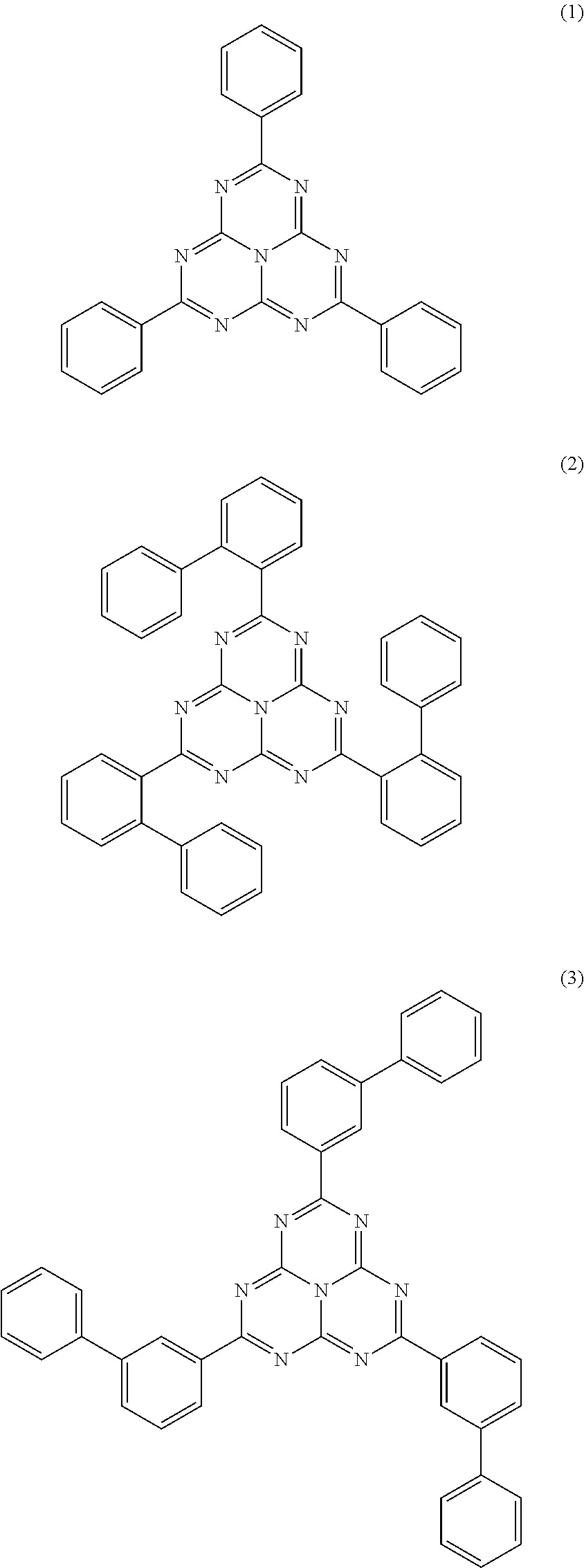Organic electronic device
a technology of electronic devices and organic materials, applied in the field of organic electronic devices, can solve the problems of reducing the efficiency and operating voltage of organic materials, reducing the efficiency of organic materials,
- Summary
- Abstract
- Description
- Claims
- Application Information
AI Technical Summary
Benefits of technology
Problems solved by technology
Method used
Image
Examples
example 1
Synthesis of tricyanoheptaazaphenalene (HIM-1)
[0089]
[0090]50 g (181 mmol) of trichloroheptaazaphenalene and 53.45 g (597 mmol, 3.3 equivalents) of copper(I) cyanide are suspended in 750 ml of DMF and heated at 130° C. for 60 h under argon. After cooling to room temperature, the reaction mixture is added to 1000 ml of concentrated ammonia solution and stirred vigorously in air for 4 h. The organic precipitate which deposits in the process is filtered off with suction and washed with cold ethanol. The residue is extracted with acetonitrile in a Soxhlet apparatus, the precipitate which crystallises out is filtered off with suction, washed with a little cold acetonitrile and dried in vacuo. Yield: 39.1 g (157 mmol), 87% of theory; purity about 99.8% (HPLC).
example 2
Production and Characterisation of Organic Electroluminescent Devices
[0091]OLEDs according to the invention are produced by a general process in accordance with WO 04 / 058911, which is adapted to the circumstances described here (layer-thickness variation, materials used).
[0092]In Examples 3 to 8 below, the results for various OLEDs are presented. Glass plates coated with structured ITO (indium-tin oxide) form the substrates of the OLEDs. For improved processing, 20 nm of PEDOT (spin-coated from water; purchased from H. C. Starck, Goslar, Germany; poly-(3,4-ethylenedioxy-2,5-thiophene)) are applied to the substrate. The OLEDs consist of the following layer sequence: substrate / PEDOT 20 nm / hole-injection layer (HIL) 5 nm / hole-transport layer (HTL-1) 20 nm / hole-transport layer (HTL-2) 20 nm / emission layer (EML) 30 nm / electron-transport layer (ETL) 20 nm and finally a cathode.
[0093]The materials apart from PEDOT are applied by thermal vapour deposition in a vacuum chamber. The emission l...
PUM
| Property | Measurement | Unit |
|---|---|---|
| glass transition temperature TG | aaaaa | aaaaa |
| glass transition temperature TG | aaaaa | aaaaa |
| glass transition temperature TG | aaaaa | aaaaa |
Abstract
Description
Claims
Application Information
 Login to View More
Login to View More - R&D
- Intellectual Property
- Life Sciences
- Materials
- Tech Scout
- Unparalleled Data Quality
- Higher Quality Content
- 60% Fewer Hallucinations
Browse by: Latest US Patents, China's latest patents, Technical Efficacy Thesaurus, Application Domain, Technology Topic, Popular Technical Reports.
© 2025 PatSnap. All rights reserved.Legal|Privacy policy|Modern Slavery Act Transparency Statement|Sitemap|About US| Contact US: help@patsnap.com



